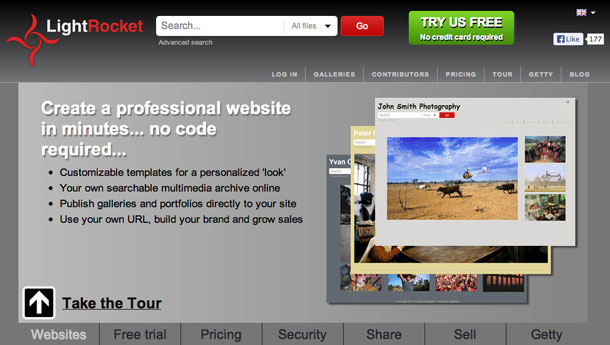Here’s one for the budding and seasoned photographers among you. A new online photo service has just been launched called LightRocket. The service is the brainchild of photographers Peter Charlesworth and Yvan Cohen, the co-founders of OnAsia Images, an online photo agency created over a decade ago representing a select group of professional photographers covering the Asian region. Thus, LightRocket is an especially interesting service for working photographers:
This new site is not only a radical move away from traditional agency representation — which usually involves taking a 50% commission on image licenses and 30% of assignment fees. The new service bristles with useful features, offering a plethora of features to its members for which it charges a reasonable monthly or yearly fee.

Subscribers can license their work directly to their own customers and to LightRocket’s global client base and collect 100% of the fee — that’s right, no commissions!
And anybody can take the LightRocket for a spin for 30 days with no credit card required and no commitment. Just click on the “Try Us Free” button at the top of the homepage.
I recently talked with LightRocket CEO Peter Charlesworth about the new site and asked him why the change and why he believes LightRocket, which joins a growing list of online offerings in this field, will be of particular value to photographers.
Peter, why yet another image hosting service?
Well choice is always good. And none of the services are the same, each has a slightly different emphasis, a slightly different interface and a slightly different range of services. I would emphasize that LightRocket is not just another hosting service, we are much more than that, hosting is just a part of what we’re offering.
In fact, we want to find that space where we can offer valuable services to serious amateurs and professionals while managing a curated archive which will be a resource for picture buyers around the world. Since we come from an agency background, having run the OnAsia agency for almost a decade and being photographers ourselves, we are keen for LightRocket to be a platform for fantastic photography by people who are passionate about creating images. We’re looking forward to seeing wonderful work coming in and to putting that work in the “spotlight” on our homepage and promoting it to our client base that consists of many thousands of editors around the world.
LightRocket is more like a tool for photographers combined with a sales and marketing platform. You can back up your archive and that’s great value right there, but you can also quickly create a website to present your work, you can build a datebase of contacts and communicate with them directly from LightRocket and if you have a premium account you can be listed in our directory which can then be searched by picture editors — who can also follow their favorite photographers so they’ll get updates when you change location or if you post a new gallery or portfolio.
LightRocket is a sophisticated archive management tool too — it has grown out of our own experience of managing large archives of images, so it includes quite a granular and, we hope, intuitive interface for somebody who is serious about their archive and values it as a resource that needs management and can be developed as an economic resource too.
What makes LightRocket truly different from the rest and unique?
I think LightRocket has quite a professional feel to it. And by that I mean it feels like a professional tool both for the subscribers who are uploading to our system and managing and distributing their archives and for picture editors and other visitors to the site who are looking for great photography.
We understand that in a highly competitive market, and faced by the complex challenges of managing growing digital archives, photographers will see value in a service that can give them the peace of mind of knowing their files are securely backed up and accessible at anytime from anywhere (with an internet connection) as well as giving them the ability to tame the chaos that a large digital archive can become.
With LightRocket, you can classify and index your files, you can promote them, you can present them in a slick-looking easy-to-create website and you can control who sees and downloads them. For a very modest monthly or yearly fee LightRocket is delivering a lot of value simply through the tools and services we’re making available.
But when one considers we are also presenting our archive to thousands of professional pictures and creating opportunities for sales, the entire package starts to look very attractive. Our hope is that picture sales from LightRocket will offset the very modest costs for subscribers. Remember, all sales take place directly between the buyer and the picture owner, so there are no commissions and no fees. 100% of the sale goes to the photographer.

You’ve been in the the business for quite a while and the OnAsia agency seemed pretty well established, so why the change?
Well the changes were driven by what’s been happening in the industry really. As you know, digital technology has transformed the world of photography in ways we didn’t imagine or foresee 10 years ago.
For one the falling cost of digital photography and universal access to the means of creating images made it possible for almost anybody to create pictures at any time. The camera went from this fairly bulky, fairly heavy, fairly pricey piece of gear to a pocket sized (or smaller) technological gadget that is about as common as the ballpoint pen (although still not quite as cheap — yet).
To a large extent it became a question of supply and demand. As it became easier and cheaper produce and distribute imagery via the internet, we saw a veritable tidal wave of pictures flood onto what had been quite specialised market — the preserve till then, dare I say it, of a relatively elite group of professionals who carried multiple cameras, wined and dined with the right editors and called themselves Photographers, with a capital P.
As supply surged, however, there was inevitable downward pressure on the price of image licenses. Pictures were suddenly easy to create and easy to find, so it made sense that their perceived value, at least from a purely economic perspective (I’m not talking about art here), began to fall.
Where there’s an opportunity there’s always millionaire investor or two waiting to cash in. As the once arcane world of photo licensing moved from being a chummy, hand-shake, behind-closed-doors affair and entered the arena of massive online trading where size matters, the nature of the industry changed and the modus operandi of traditional agencies like ours very quickly started to look dated.
Enter such major players as Getty (created by a scion of the Getty dynasty) and Corbis (created by Microsoft founder Bill Gates). Seeing how easily pictures could be distributed and shared online, Mark Getty famously described intellectual property “as the oil of the 21st century.”
At OnAsia we were always pretty old school and for as long as possible we tried to maintain the values of a traditional agency: working exclusively with hand picked photographers, focusing on a niche and, whenever possible, charging premium rates for premium work.
But as the years passed, we realized we were swimming against an ever stronger tide until it reached point where we realised we were faced with diminishing returns. As prices fell and as our clients increasingly turned to the major players for their imagery, it became less and less worthwhile to split ever smaller license fees.
The idea of LightRocket was thus borne out of a necessity to adapt to a changing market. Both Yvan and I felt that we could best serve our members by providing a service that was of real value to them in return for a small fee, while removing ourselves from the license transaction process and allowing the photographer to collect 100% of that value.
Concept and coding took you guys a long time. What were the main obstacles?
I don’t think any software project of this scale and complexity happens very quickly. Indeed I don’t feel the time invested in developing LightRocket is important at this point. What matters is that we’re now live, that we have a great service to offer and that our service will continue to evolve and improve over time. We certainly wouldn’t have dreamt of rushing the development of our systems. It’s important to get things right, to ensure our code is tried and tested and to take the time to develop concepts that translate into an intuitive and user-friendly experience. So if there were obstacles, I suspect they were no different from any company building a system as comprehensive as LightRocket’s. Indeed the complexity and breadth of these types of systems probably explains why the market is not more crowded with companies offering these types of services.
Whom are you mainly reaching out too?
Since our roots are firmly in the world of photography and that is our first passion, I would have to say we’re reaching out to photographers first and foremost. But we have conceived LightRocket to respond to the needs of a multimedia age, so the system handles video, audio files, PDFs and other file types too. So while photography is clearly our focus, LightRocket is very versatile. And we don’t place limits on files sizes either, so users can upload files of any size. It’s their work and their archive and LightRocket lets them manage it as they please.
Can you give a hint of future features in the pipeline?
Sure. We have lots of features planned. I don’t want to list them all here because the list would be too long. First of all we’re introducing small upgrades and improvements all the time. We love feedback and respond to it. That doesn’t mean we can implement changes to suit everybody but we are keen to respond to the needs of our users, of course. In terms of features, we’ll be looking to add new templates and to further develop the website management area as we see that as an area of core value for our users. We’re also planning on introducing an image request feature that would allow picture buyers to post picture requests to which subscribers could respond.
+++ Time to check out the service. Find out more on LightRocket.


